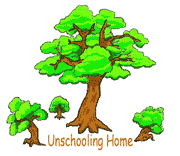Robyn Coburn:
I think I told the story once before about a mom at a park day whose toddler hadn't wanted to bring along her sweater after being told to, so the Mom left it behind and said to me "That's how they learn." The little girl was freezing, couldn't play and in the end the whole family had to leave early.But what did the little girl learn? That she can't rely on Mom to protect or help her—maybe that she should do as she is told, but you can imagine the resentment in her heart at this mean lesson. "Mom was right, darn her."
What if Mom had secreted the sweater in her bag, and been able to pull it out and hand it to the little girl. The little girl would still have learnt that Mom sometimes has good suggestions about when it is cold, but she would have had the memory of being loved and saved and warmed. "Gee Mom was right and I love her".
—Robyn L. Coburn *
Pam Sorooshian, from a July 2012 discussion at Always Learning:
This is for Kate and anybody else who wants to better understand why people on this list regularly object to use of the word "teach."Most of our values are picked up as we live our lives. Some through hard/sad experience (getting caught in a lie, for example) and some by being around people we admire who live by certain values. There is also a lot of conversation in our house, at least, about behavior and character. So when people refer to teaching children good morals, they might mean by experience, example, and conversation.
However, parents who try to instill morals in the usual punish and reward style of teaching often provide different lessons than they intend. For example, they may try to teach a child to be kind, using teaching methods that are inherently unkind (reward and punishment methods). Because teaching so often implies using these behaviorist techniques on children, better to avoid the use of the term and discuss learning and helping our children learn, instead. Helping them learn has gentler and kinder and more clear implications for those who have experienced school-style teaching and harsh or hypocritical parent-style teaching. It puts our attention on ways to help our kids learn other than reward and punishment techniques.
The words we use to convey our meaning, aren't our meaning.
The words we use land in someone else's head and they use *their* meaning not ours.
That works fine when we're talking about something concrete that every one knows. A horse. An apple. A school.
A zookeeper who, out of context, mentions cats, will conjure images of house cats in most people even when they intended "box" (cat) that's carrying their meaning to refer to big cat. If the zookeeper is speaking to another zookeeper, the other zookeeper may hear "cat" and immediately attach "big cat" to the word.
Communication becomes difficult when a word has many very different meanings, meanings often gathered from a lifetime of how someone has experienced the word used.
A teacher, for example, might have a very hard time seeing learning and teaching as separate. She'll see them as inextricably linked. Learn will mean teach and taught. Teach will mean learn. (Or "They're at fault if they didn't learn because *I* did my part!")
The average person's TEACH "box" connects to:
But worse, in terms of communication, is they've used a word that most people will translate into their school experience with the word TEACH. It won't matter what the speaker meant TEACH to mean. Those who heard (or read) will think most prominently, "instruct kids in morals", "test their understanding of morals", "reward right morals", "punish wrong morals". The ideas they come up with on how to "teach morals" will be heavily weighted towards their school experience with TEACH: "pouring the knowledge in", "testing to see if the child has memorized it", "punishing if it wasn't learned".
Which is why long time posters on the list try to help people see how learning is a completely separate idea from teaching. Teaching is pouring knowledge over a child. Whether a child takes it in is not in the teacher's power. Which is why teachers punish and reward to make not taking in an idea less pleasant.
Learning is a child pulling in ideas. Those ideas are most full of life when those ideas connect to other ideas the child is fascinated by. It makes no difference if those ideas connect along a particular path. Which is why natural learning looks so chaotic and meandering compared to school.
It makes it hard to create an environment for a child to explore freely and pull in what fascinates them when someone is unschooling through a fog of TEACH.
Joyce Fetteroll's response:
Good explanation.
I've given two talks on the subject of word use and I'm still not sure I've worked up a good analogy 😉
The strongest connection to the average person's LEARN "box" will be those items that connect to the TEACH "box". Weaker connections will be to experiences of learning by exploring. But what people learn by exploring is rarely taken seriously. Learning by exploring is chaotic, rambling, can't be counted on to get some specific bit of learning. So those links are not only weak, they're inferior. Those links will include, some of which Pam listed,
When someone says "Teach morals" we can't know which ideas from the list they intended the word TEACH to have.

